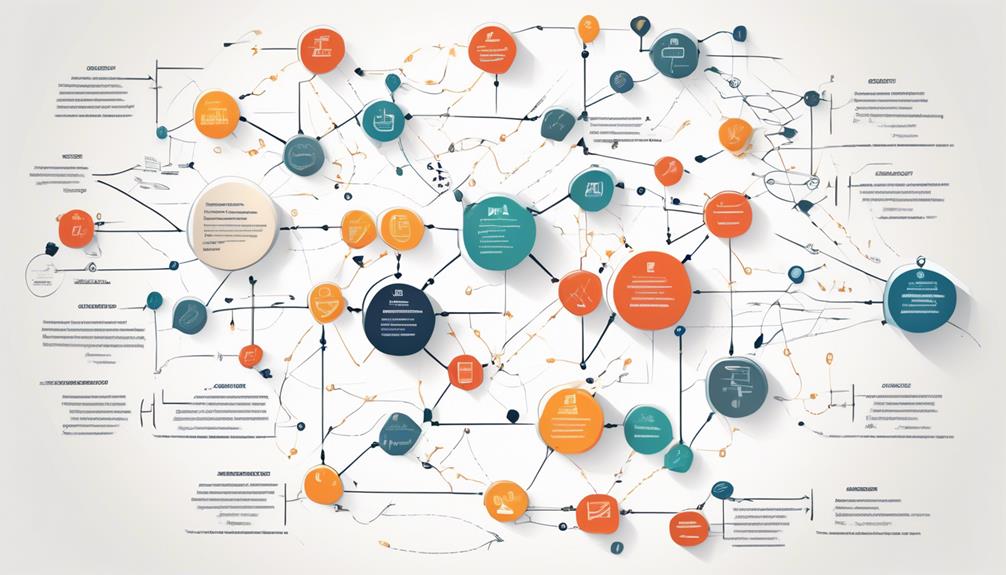Ensuring the quality of our products presents more challenges than anticipated. The integration of risk management and quality assurance is vital and demands our undivided attention.
It's not just about meeting regulatory requirements; it's about safeguarding our reputation, customer satisfaction, and overall business success.
By exploring the intricate relationship between risk management and quality control, we can uncover a wealth of benefits and insights that might just reshape the way we approach quality assurance.
Key Takeaways
- Integration of risk management with quality control enhances the quality of products and services.
- Integrating risk allows for effective resource allocation based on the level of risk.
- Integrating risk management includes identifying potential risks, assessing their impact, developing mitigation strategies, and monitoring effectiveness.
- Integration of risk management and quality control leads to improved operational performance, increased customer satisfaction, and better decision-making.
Importance of Integrating Risk and Quality
Integrating risk management with quality control is crucial for ensuring the overall success and reliability of our products and services. By integrating risk-based quality management, we can proactively identify potential issues that may impact the quality of our products, allowing us to take preventive actions to mitigate these risks. This approach not only enhances the quality of our products but also improves our operational efficiency and customer satisfaction.
Integrating risk into our quality control processes enables us to prioritize our efforts based on the level of risk associated with specific aspects of production and service delivery. This ensures that we allocate resources effectively, focusing on areas that have the highest potential impact on quality. Additionally, by integrating risk management with quality control, we can create a more comprehensive and cohesive approach to managing all aspects of our operations.
Furthermore, integrating risk management with quality control fosters a culture of continuous improvement. It encourages us to constantly evaluate and refine our processes, leading to greater consistency and reliability in the products and services we offer. Ultimately, by integrating risk into our quality control practices, we can't only meet but exceed the expectations of our customers.
Understanding ISO 9001:2015 Standards

Let's start by understanding the key principles of ISO 9001:2015 and its emphasis on risk-based thinking.
ISO 9001:2015 requires organizations to integrate risk management into their quality management systems, ensuring a proactive approach to addressing risks and opportunities.
It's essential to grasp the overview of ISO 9001:2015 and its impact on quality principles to effectively implement risk-based thinking in our quality control processes.
ISO 9001:2015 Overview
Understanding ISO 9001:2015 standards is essential for organizations aiming to integrate risk-based thinking into their quality management systems. This standard introduces the concept of risk-based thinking, emphasizing the need to consider risks and opportunities in all aspects of the Quality Management System (QMS). Integration of risk management into quality control processes includes identifying potential risks to quality objectives, assessing their impact, developing mitigation strategies, and monitoring the effectiveness of integration. Here's a table to illustrate the benefits and challenges of integrating risk and quality management in ISO 9001:
| Benefits | Challenges |
|---|---|
| Improved customer satisfaction | Understanding and applying risk-based thinking |
| Enhanced competitiveness | Defining and prioritizing relevant risks |
| Increased efficiency | Integrating different tools and techniques |
| Better alignment with standards | Communicating with stakeholders |
Understanding ISO 9001:2015 standards is crucial for organizations seeking to enhance their quality management systems through effective risk management.
Key Quality Principles
After exploring the concept of risk-based thinking in the ISO 9001:2015 standards, it's imperative to delve into the key quality principles that underpin this framework.
The integration of risk management with quality management in ISO 9001:2015 is based on several key principles. These include the need to consider risks and opportunities in all aspects of the Quality Management System (QMS), planning and implementing actions to address these risks and opportunities, and aligning these actions with quality objectives.
It's important to note that risk-based thinking isn't a separate process or clause in the standard; it's an integral part of the entire QMS. Integrating risk and quality management can lead to improved customer satisfaction, competitiveness, efficiency, innovation, and alignment with other standards.
However, challenges may arise in understanding and applying risk-based thinking, defining relevant risks, and effectively communicating with stakeholders.
Risk-Based Thinking
In implementing ISO 9001:2015 standards, organizations must incorporate risk-based thinking as a fundamental concept throughout their Quality Management System (QMS). This approach requires considering risks and opportunities across all QMS processes, rather than treating it as a distinct component. Integrating risk-based thinking enhances customer satisfaction, competitiveness, and efficiency. It also aligns with other standards and frameworks, contributing to overall organizational success.
However, challenges exist in this integration, including understanding and applying risk-based thinking, defining relevant risks, integrating various tools, communicating with stakeholders, and monitoring performance. Overcoming these challenges is essential for effective quality risk management.
Benefits of Integration in ISO 9001

When integrating risk management with quality control in ISO 9001, we can experience a range of benefits.
These include meeting the requirements of ISO 9001, improving risk identification, and enhancing decision-making processes.
ISO 9001 Requirements
Integrating risk management with quality control in accordance with ISO 9001:2015 requirements offers a strategic approach to identifying and addressing risks and opportunities within the quality management system. ISO 9001:2015 introduces risk-based thinking, integrating risk management into the heart of the quality management system.
This approach ensures that quality management processes are designed to consider potential risks and opportunities, leading to improved performance and sustainability. By integrating risk management with quality management, organizations can enhance their ability to meet customer requirements, improve competitiveness, and achieve greater operational efficiency.
This integration also leads to better identification and mitigation of quality risks, thereby strengthening quality control processes and ultimately resulting in increased customer satisfaction. Embracing ISO 9001 requirements for integrating risk and quality management can significantly improve overall organizational performance and resilience.
Improved Risk Identification
By aligning risk identification with quality management, we can enhance customer satisfaction and loyalty while also strengthening our competitiveness and reputation. This integration allows for improved risk identification through a risk-based approach, leading to several benefits:
- More comprehensive understanding of potential risks.
- Better anticipation and mitigation of quality-related issues.
- Enhanced ability to proactively address customer concerns.
- Improved decision-making based on a thorough risk assessment.
- Increased confidence in our products and services due to a proactive risk management approach.
These advantages not only contribute to meeting ISO 9001 requirements but also foster a culture of continuous improvement, positioning us as a leader in our industry.
Enhanced Decision Making
As we align risk identification with quality management, we enhance our ability to make informed and proactive decisions, yielding significant benefits for our organization within the framework of ISO 9001.
By integrating risk management with quality control, we gain a comprehensive understanding of potential risks and their potential impact on the quality of our products or services. This understanding enables us to make more precise and effective decisions, leading to improved operational performance and customer satisfaction.
Additionally, by considering both risk and quality factors in decision-making processes, we're better equipped to prioritize resources and allocate them where they're most needed.
Ultimately, this integration enhances our organization's ability to adapt to changing circumstances and make strategic decisions that positively impact our overall performance and success.
Addressing Challenges in Integration

Addressing the challenges in integrating risk and quality management requires a comprehensive understanding of the organization's operations and a proactive approach to identifying and prioritizing relevant risks and opportunities. This process involves several key considerations:
- Understanding and applying risk-based thinking across the organization is crucial for successful integration of risk management and quality control.
- Defining and prioritizing relevant risks and opportunities is essential to ensure that the integration process addresses the most impactful areas.
- Integrating different tools and techniques for risk and quality management poses a challenge, requiring careful evaluation and alignment of methodologies.
- Effective communication with stakeholders about risks is necessary to address challenges in integration and ensure that all relevant parties are informed and engaged.
- Monitoring the performance and effectiveness of risk and quality management actions is vital to overcoming integration challenges and continuously improving the integrated approach.
Key Concepts in Risk Management

To ensure a successful integration of risk management and quality control, it's essential to grasp the key concepts in risk management and their impact on organizational objectives.
The risk management process involves identifying, analyzing, evaluating, and treating uncertainties that may affect the achievement of objectives. It provides a structured approach to dealing with potential events that may hinder the organization's ability to fulfill its mission.
One crucial concept in risk management is the idea of risk-based thinking, which emphasizes the proactive consideration of risks in all activities and decision-making processes. Understanding this concept enables organizations to identify opportunities, allocate resources more effectively, and enhance the likelihood of achieving desired outcomes.
Incorporating risk-based thinking into the quality management process allows organizations to address potential issues before they escalate into significant problems. By integrating risk management into quality control, organizations can prevent quality-related issues that may have adverse effects on the achievement of objectives.
Moreover, this integration also allows for a more holistic approach to organizational performance, ensuring that both risk and quality considerations are aligned with strategic goals.
Implementing Risk-Based Thinking

We will integrate risk-based thinking into our quality control processes to proactively identify and address potential risks that may impact our objectives and quality outcomes. This integration involves identifying and assessing potential risks that may affect our objectives and quality outcomes.
Additionally, we'll integrate risk management into our quality control processes to maintain and enhance quality standards. Developing strategies to mitigate and address risks is crucial to upholding our quality objectives.
Furthermore, we'll monitor and review the effectiveness of integrating risk management and quality control to ensure continuous improvement. Implementing actions to address risks and opportunities across all aspects of the Quality Management System (QMS) is essential for a comprehensive approach to risk management and quality management.
- Identify and assess potential risks
- Integrate risk management into quality control processes
- Develop strategies to mitigate and address risks
- Monitor and review the effectiveness of integration
- Implement actions to address risks and opportunities across all aspects of the QMS
Advantages of Quality Risk Management

Integrating quality risk management into our processes has proven to be advantageous in preventing and reducing quality problems, enhancing customer satisfaction and loyalty, as well as improving competitiveness and reputation. By actively managing risks, we can identify and address potential quality issues before they escalate, ultimately leading to higher product and service quality. This proactive approach not only ensures that customer expectations are consistently met but also fosters trust and loyalty, leading to repeat business and positive referrals.
Furthermore, integrating risk management with quality management enhances our competitiveness in the market. By effectively managing risks, we can streamline processes, reduce waste, and optimize resource allocation, resulting in cost savings and increased efficiency. This, in turn, allows us to offer competitive pricing while maintaining high-quality standards, positioning us as a preferred choice in the marketplace.
Moreover, a strong focus on quality risk management contributes to building and safeguarding our reputation. By consistently delivering products and services that meet or exceed expectations, we establish ourselves as a reliable and reputable brand, earning the trust and confidence of our customers and stakeholders. This positive reputation further strengthens our position in the market and opens doors to new opportunities for growth and expansion.
Mitigating Risks in Quality Control

Improving quality and reducing risks through integration with quality control systems allows us to proactively mitigate potential issues before they impact our products and services. When it comes to mitigating risks in quality control, we employ various strategies and tools to ensure the highest standards are maintained. These include:
- Implementing robust risk assessment processes that identify potential quality issues and their impact on products and services.
- Utilizing quality control measures such as FMEA (Failure Mode and Effects Analysis) to proactively address and mitigate potential risks in the production process.
- Conducting regular reviews and audits of quality control procedures to identify and address any potential weaknesses or areas for improvement.
- Involving cross-functional teams in risk management and quality control to ensure comprehensive and diverse perspectives are considered.
- Leveraging technology and data analysis to continuously monitor and improve quality control processes, identifying and addressing potential risks in real time.
Successful Integration Strategies

With a focus on enhancing operational efficiency and customer satisfaction, successful integration strategies for risk management and quality control play a crucial role in modern business practices. By aligning these two critical functions, organizations can improve their overall performance, ensure compliance with standards, and mitigate potential quality risks. Below, we outline key strategies for successfully integrating risk management and quality control:
| Integration Strategies | Description | Benefits |
|---|---|---|
| Understand Risk-Based Thinking | Embrace the principles of risk-based thinking outlined in ISO 9001:2015 to incorporate risk considerations into quality management processes. | Prioritize risk remediation efforts and improve management system performance. |
| Align Processes Across Departments | Ensure that risk management and quality control processes are aligned across different departments, promoting a unified approach to risk identification and mitigation. | Enhance the identification and mitigation of quality risks and improve quality control processes. |
| Prioritize Relevant Risks | Focus on prioritizing relevant risks that could impact the quality of products or services, thus enabling a targeted and effective risk management approach. | Increase customer satisfaction and competitiveness while ensuring compliance with standards. |
Frequently Asked Questions
Why Is It Important to Integrate Risk Management Into Quality Control Processes?
Integrating risk management into quality control processes is crucial because it helps prevent and reduce quality problems by identifying and treating uncertainties. It enhances performance, sustainability, and customer satisfaction.
ISO 9001:2015 emphasizes risk-based thinking, requiring organizations to consider risks and opportunities in all aspects of the Quality Management System. This integration leads to increased efficiency, effectiveness, competitiveness, and reputation while fostering innovation and learning.
How Does Risk Management and Quality Management Work Together?
We integrate risk management with quality control by identifying potential uncertainties that could impact our objectives and implementing measures to treat them. This helps us maintain high standards and deliver value to our stakeholders.
How Do Risk Management and Quality Management Work Together Overlap?
In our organization, risk management and quality management work together to overlap in several key areas. We identify potential uncertainties that may impact our objectives and take proactive measures to prevent quality issues.
By integrating risk and quality management, we enhance customer satisfaction, increase efficiency, foster innovation, and align with industry standards.
Challenges include applying risk-based thinking across the organization, integrating tools and techniques, and effectively communicating with stakeholders about risks.
What Is the Link Between Risk Management and Quality Improvement?
The link between risk management and quality improvement is like a tightly woven fabric. Identifying potential risks to quality objectives, assessing their impact on outcomes, and developing mitigation strategies maintain the fabric's integrity.
Integrating risk management into quality control processes ensures that the fabric remains strong and resilient. This integrated approach helps us optimize performance and effectiveness, fostering innovation and learning.
Additionally, it aligns with industry standards and frameworks, providing a solid foundation for continuous improvement. By recognizing the interdependence of risk management and quality improvement, we can enhance our ability to deliver high-quality products and services to our customers.
Conclusion
In conclusion, integrating risk management with quality control is like having a guardian angel watching over your products and services, ensuring they're of the highest standard.
By embracing risk-based thinking and addressing potential challenges, organizations can soar to new heights of customer satisfaction and operational efficiency.
It's the secret ingredient that sets successful organizations apart, allowing them to navigate potential pitfalls and emerge as industry leaders.
Rick, our Software Quality Assurance Writer, is the creative force behind many of our insightful articles and course materials. His unique background in software development, fused with his natural flair for writing, allows him to convey complex QA concepts in a way that is both informative and captivating. Rick is committed to keeping abreast of the latest trends and advancements in software testing, ensuring that our content remains not just relevant, but at the forefront of the field. His significant contributions are instrumental in helping us fulfill our mission to deliver premier QA education.










